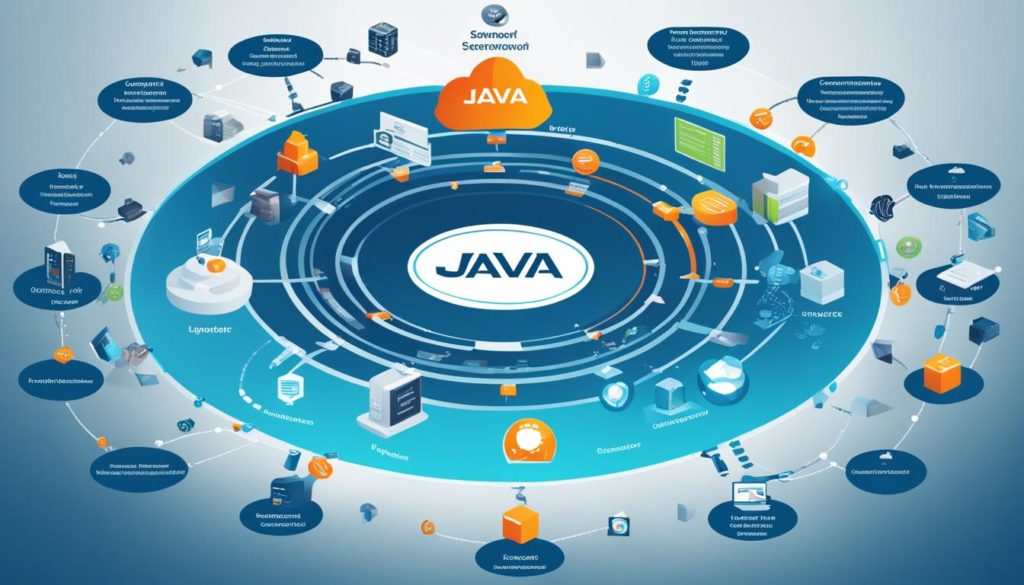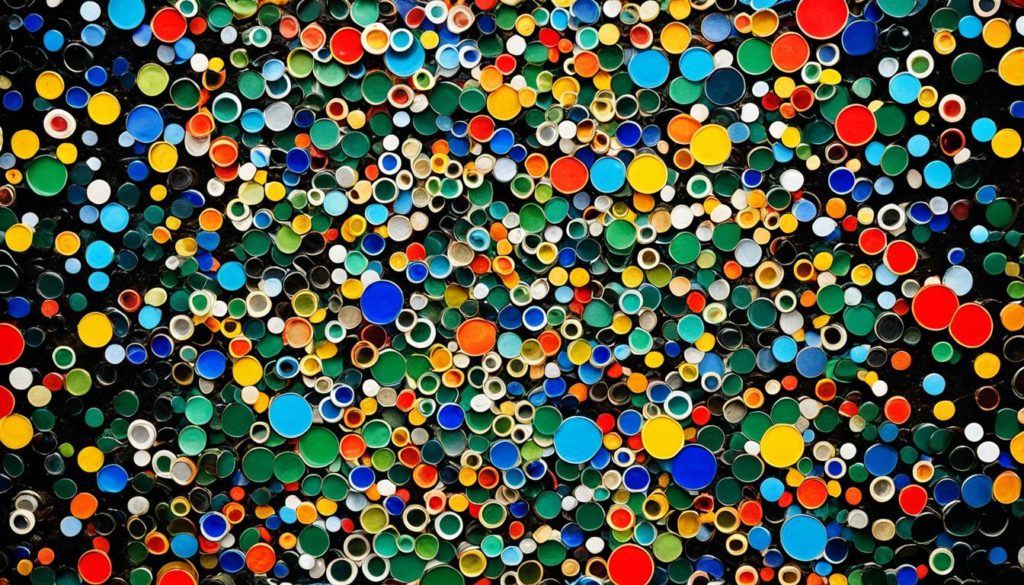
The JVM closely watches over the garbage collection process as developers create objects in Java programs. This overlooked part is key to making Java applications run smoothly. By knowing the JVM architecture and Java Memory Model, developers can improve application stability. This way, they avoid common problems like memory leaks.
Java’s garbage collection has several main points. It involves JVM heap memory, generational spaces, and the mark-and-sweep algorithm. The memory is divided into the Young Generation (including Eden space and survivor spaces), Old Generation (Tenured), and Permanent Generation (Metaspace). During minor GC, Java cleans the Eden space and moves objects to survivor spaces or the Old Generation. Major GC, on the other hand, reclaims memory from objects in the Old Generation.
It’s important for developers to understand these strategies. This knowledge is crucial for making garbage collection work better and ensuring applications last longer. Java offers different garbage collectors like the Serial, Parallel, CMS, G1, ZGC, and Shenandoah. Each suits different application needs. Learn more about how to optimize garbage collection for a smoother Java app experience.
Key Takeaways
- JVM manages the garbage collection process to monitor memory usage as developers create objects.
- Garbage collection includes Young Generation, Old Generation, and Permanent Generation spaces.
- Minor GC events clean Eden space and move objects to survivor or Old Generation spaces.
- Major GC reclaims memory from long-lived objects in the Old Generation.
- Multiple garbage collectors, such as CMS and G1, serve distinct application scenarios.
- Optimizing garbage collection helps improve Java application performance and stability.
Introduction to Java Garbage Collection
Java Garbage Collection is key to Java’s memory management. It makes sure memory is used and removed efficiently. This process helps apps work better and avoid memory problems.
What is Garbage Collection?
The JVM automatically manages memory through a process called garbage collection. It frees up memory by getting rid of things the program no longer needs. This stops memory-related issues that can crash apps. To grasp this method, check out Oracle’s tutorial on garbage collection.
Importance of Automatic Memory Management
In Java, the JVM handles memory automatically. Developers don’t need to worry about manual memory tasks. This reduces errors, boosts work speed, and allows building better features. It ensures apps run well and are responsive.
Challenges of Manual Memory Management
Handling memory manually in Java can be hard. It includes managing space and avoiding memory troubles. The Garbage Collector eases these issues by managing unused memory. Understanding this helps in making apps perform better.
How Garbage Collection Works in Java
Understanding how Java’s garbage collection works is key for good performance and memory use. The Java Virtual Machine helps make sure programs work well. It does this by preventing memory issues and reducing extra work.
The Java Memory Model
The Java Memory Model splits memory into stack and heap. Stack memory is for short-lived items, while the heap is for objects. Effective garbage collection tuning in the JVM manages how memory is used, aiding performance.
Young Generation and Old Generation
The heap memory has the Young Generation and the Old Generation. New items start in the Young Generation. Items that survive long enough move to the Old Generation. Adjusting the heap size for these areas can make garbage collection work better.
Minor vs Major Garbage Collection
The JVM has Minor and Major Garbage Collection. Minor GC happens a lot and cleans up the Young Generation. Major GC is less frequent but does a big clean of the Old Generation. Knowing this helps with tuning the JVM for better garbage collection.
Mark, Sweep, and Compact Phases
Garbage collection happens in three steps: Mark, Sweep, and Compact. Mark finds what memory to keep. Sweep gets rid of unused memory. Compact puts the used memory together neatly. Tackling each step can improve the garbage collection process.
Understanding Java’s garbage collection, including memory structures and cleaning phases, helps developers. By adjusting heap sizes and tuning the JVM, they can make Java applications run well. This makes applications work smoothly and efficiently.
| Aspect | Description |
|---|---|
| Java Memory Model | Structures memory into stack and heap, focusing on garbage collection. |
| Young Generation | Where new objects are allocated, subdivided into Eden Space and Survivor Spaces. |
| Old Generation | Where long-lived objects are promoted after surviving multiple GC cycles. |
| Minor Garbage Collection | Frequently cleans up the Young Generation. |
| Major Garbage Collection | Less frequent, more intensive, cleans the Old Generation. |
| Mark Phase | Identifies all live objects by traversing the object graph. |
| Sweep Phase | Clears memory occupied by unmarked dead objects. |
| Compact Phase | Defragments the heap space to optimize memory allocation. |
Different Types of Java Garbage Collectors
Choosing the right garbage collector is key for good JVM performance. It’s picked to fit your app’s unique needs. With Java, you get different collectors for different jobs. This means Java apps can work well even with lots of different tasks.
Serial Garbage Collector
The Serial Garbage Collector is the most basic type in Java. It’s for apps that use just one thread or have small memory needs. It stops all your app’s threads while it cleans up, which can slow things down. But, its simple way of working keeps things moving fast in many cases.
Parallel (Throughput) Garbage Collector
The Parallel Garbage Collector helps apps run faster by using many threads at once. This is great for systems that need to keep working strong to the end. It cuts down the time spent on cleaning up memory. So, your app runs more smoothly.
CMS (Concurrent Mark-Sweep) Garbage Collector
The CMS Garbage Collector is all about keeping your app going without long pauses. It’s perfect for things like online games or other apps that have to respond quickly. CMS cleans up memory in the background so users hardly notice it’s happening.
G1 (Garbage-First) Garbage Collector
The G1 Garbage Collector aims for both speed and few pauses. This is just what big apps need. It chooses the most important memory to clean up first. This way, your app can plan for any short breaks in action.
ZGC and Shenandoah
ZGC and Shenandoah are the newest kids on the block for memory cleanup in Java. They are perfect if your app can’t have any delays. Great for games that need to respond in real-time. They work while your app runs, keeping things smooth.
Here’s a comparison of different garbage collectors:
| Garbage Collector | Optimal Use Case | Performance Characteristics |
|---|---|---|
| Serial | Single-threaded, small heaps | High pause time, minimal overhead |
| Parallel (Throughput) | Maximizing application throughput | Reduced overall GC time with multiple threads |
| CMS | Low-latency applications | Concurrent GC, reduced pause times |
| G1 | Large heap sizes, balanced performance | Predictable pauses, region-based collection |
| ZGC/Shenandoah | Performance-critical with large heaps | Ultra-low latency, high responsiveness |
Optimizing Java Garbage Collection
Optimizing Java Garbage Collection is not just turning a few knobs. It involves deep understanding. This strategy looks at how different JVM parameters, garbage collectors, and heap sizes affect overall performance. By using the right methods, we aim for apps to respond quickly while handling lots of user requests. These methods are key for places like LinkedIn.
Strategies for Tuning JVM Performance
Improving the Java Virtual Machine (JVM) starts by picking the best garbage collector. It also means setting up the JVM just right. We can tell what to tweak by looking at GC logs and visualizations. For example, LinkedIn found that with some changes, they cut down pauses and delays a lot. Such adjustments make a big difference in how apps perform.
Heap Size Adjustments
Tweaking the heap size is key for better garbage collection. Bigger heaps mean less garbage collection but longer pauses. By changing the size of the young generation and other settings, we can make garbage collection smoother. This also helps manage CPU and memory use better.
Choosing the Right Garbage Collector
Picking the best garbage collector is crucial for managing memory in Java. Different collectors suit different app needs. For example, CMS is good for apps that must keep going without long pauses. G1 is better for large apps that need stable performance. By making careful adjustments, we can make garbage collection less of a bother. This keeps our apps running smoothly and quick to respond.
FAQ
What is Garbage Collection?
In Java, Garbage Collection tackles the job of memory management. It gets rid of unused memory. This happens automatically. So, developers don’t have to worry about it.
Why is automatic memory management important?
Without automatic memory management, we’d face issues like memory leaks. These can make an app unstable. It lets developers focus on creating great apps instead of battling memory problems.
What are the challenges of manual memory management?
Doing memory management by hand can cause memory leaks and hanging pointers. These bugs can crash your app. Luckily, automatic garbage collection helps prevent these problems.
What is the Java Memory Model?
The Java Memory Model tells us how memory is organized. It groups memory into areas for efficiency. Knowing this helps developers use memory well in Java apps.
What are Young Generation and Old Generation in Java’s heap space?
When created, objects start in the Young Generation area. If they last long, they move to the Old Generation area. This strategy helps keep Java running smoothly.
What is the difference between Minor and Major Garbage Collection?
Minor garbage collection works on new objects and is quick. Major garbage collection handles older objects and can pause your app for longer.
What are the Mark, Sweep, and Compact phases in garbage collection?
First, objects used are identified in the Mark phase. Then, unneeded objects are removed in the Sweep phase. Finally, the Compact phase tidies up memory use by reorganizing objects.
What is the Serial Garbage Collector?
The Serial Garbage Collector suits simple or small Java apps. It uses a basic single-threaded method for garbage collection.
What is the Parallel (Throughput) Garbage Collector?
The Parallel Garbage Collector speeds up apps by using multiple threads. It’s great for bigger Java apps that need to run fast.
What is the CMS (Concurrent Mark-Sweep) Garbage Collector?
The CMS Collector helps apps that must respond quickly. It does its job alongside the main app, reducing pause times.
What is the G1 (Garbage-First) Garbage Collector?
The G1 Collector balances well in both speed and predictability. It’s for managing memory in large Java apps smoothly and with less pauses.
What are ZGC and Shenandoah Garbage Collectors?
ZGC and Shenandoah are for apps that need to always be ready. They are very fast, keeping garbage collection pauses to a minimum.
What strategies can we use for tuning JVM performance?
To tweak JVM, adjust flags, play with heap size, and pick the right collector. This fine-tunes your app, making it faster and more stable.
How do heap size adjustments affect garbage collection performance?
Changing the heap size can improve or worsen garbage collection. It’s a balance. A big heap might delay clean-ups but then pause the app longer later.
How do we choose the right Garbage Collector for our application?
Picking the right collector means knowing what your app needs. Each is best for certain situations. With the right choice, your app runs better.
Future App Studios is an award-winning software development & outsourcing company. Our team of experts is ready to craft the solution your company needs.










